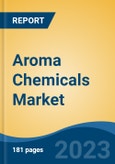Free Webex Call
The Aroma Chemicals Market was valued at USD 5.85 Billion in 2024, and is expected to reach USD 7.55 Billion by 2030, rising at a CAGR of 4.30%. The expansion is credited to a rise in the usage of flavors and fragrance items in sectors like cosmetics and toiletries, soaps and detergents, as well as food and beverages. Aroma chemicals are experiencing heightened demand due to their expanding utility in crucial end-use sectors such as dairy, cosmetics and toiletries, soaps and detergents, fine fragrances, convenience foods, bakery items, and confectionery. Additionally, the industry's growth is fueled by the rising demand for low-calorie beverages and the overall expansion of the beverages market. Speak directly to the analyst to clarify any post sales queries you may have.
10% Free customizationThis report comes with 10% free customization, enabling you to add data that meets your specific business needs.
Key Market Drivers
Increased Consumption in Cosmetics and Toiletries
The global aroma chemicals market is undergoing a notable transformation, with increased consumption in the cosmetics and toiletries sector emerging as a powerful catalyst for growth. Aroma chemicals, vital components of fragrances, are witnessing heightened demand as consumers worldwide place greater emphasis on personal care and grooming. According to recent data, 50% of Americans maintain a somewhat or highly consistent skin-care routine, with 20% reporting that their routine is very consistent. Gender differences are notable, as 60% of women adhere to a consistent routine, compared to 39% of men. Meanwhile, 18% of women and 36% of men report having no skin-care routine at all, highlighting a significant gap in personal care habits between the two groups.Key Market Challenges
Natural Ingredient Trends
One of the significant challenges confronting the aroma chemicals market is the increasing consumer preference for natural and sustainable ingredients. With the rise of clean beauty and wellness trends, there is a growing demand for fragrances derived from natural sources. This shift requires manufacturers to invest in research and development to create natural alternatives that match the performance of traditional aroma chemicals.Key Market Trends
Rise of Natural and Sustainable Fragrances
One of the most significant upcoming trends in the aroma chemicals market is the increasing demand for natural and sustainable fragrances. With consumers placing a premium on clean beauty and eco-friendly products, manufacturers are shifting their focus towards developing aroma chemicals derived from natural sources. This trend aligns with the broader movement towards sustainability and transparency in the fragrance industry.Key Market Players
- Privi Organics Ltd
- Takasago International Corp USA
- Hindustan Mint & Agro Products Pvt Ltd
- BASF SE
- Symrise AG
- Firmenich SA
- Agilex Flavors & Fragrances Inc
- Givaudan SA
- Robertet SA
- Bell Flavors & Fragrances Inc
Report Scope:
In this report, the Global Aroma Chemicals Market has been segmented into the following categories, in addition to the industry trends which have also been detailed below:Aroma Chemicals Market, By Source:
- Natural
- Synthetic
- Natural-identical
Aroma Chemicals Market, By Application:
- Flavors
- Fragrance
Aroma Chemicals Market, By Chemicals:
- Benzenoids
- Musk chemicals
- Terpenes & Terpenoids
- Others
Aroma Chemicals Market, By Region:
- North America
- United States
- Canada
- Mexico
- Europe
- France
- United Kingdom
- Italy
- Germany
- Spain
- Asia-Pacific
- China
- India
- Japan
- Australia
- South Korea
- South America
- Brazil
- Argentina
- Colombia
- Middle East & Africa
- South Africa
- Saudi Arabia
- UAE
- Kuwait
Competitive Landscape
Company Profiles: Detailed analysis of the major companies present in the Global Aroma Chemicals Market.Available Customizations:
With the given market data, the publisher offers customizations according to a company's specific needs. The following customization options are available for the report.Company Information
- Detailed analysis and profiling of additional market players (up to five).
This product will be delivered within 1-3 business days.
Table of Contents
1. Product Overview
2. Research Methodology
3. Executive Summary
5. Global Aroma Chemicals Market Outlook
6. North America Aroma Chemicals Market Outlook
7. Europe Aroma Chemicals Market Outlook
8. Asia-Pacific Aroma Chemicals Market Outlook
9. South America Aroma Chemicals Market Outlook
10. Middle East and Africa Aroma Chemicals Market Outlook
11. Market Dynamics
12. Market Trends & Developments
13. Porter’s Five Forces Analysis
14. Competitive Landscape
Companies Mentioned
- Privi Organics Ltd
- Takasago International Corp USA
- Hindustan Mint & Agro Products Pvt Ltd
- BASF SE
- Symrise AG
- Firmenich SA
- Agilex Flavors & Fragrances Inc
- Givaudan SA
- Robertet SA
- Bell Flavors & Fragrances Inc
Table Information
| Report Attribute | Details |
|---|---|
| No. of Pages | 180 |
| Published | February 2025 |
| Forecast Period | 2024 - 2030 |
| Estimated Market Value ( USD | $ 5.85 Billion |
| Forecasted Market Value ( USD | $ 7.55 Billion |
| Compound Annual Growth Rate | 4.3% |
| Regions Covered | Global |
| No. of Companies Mentioned | 10 |









